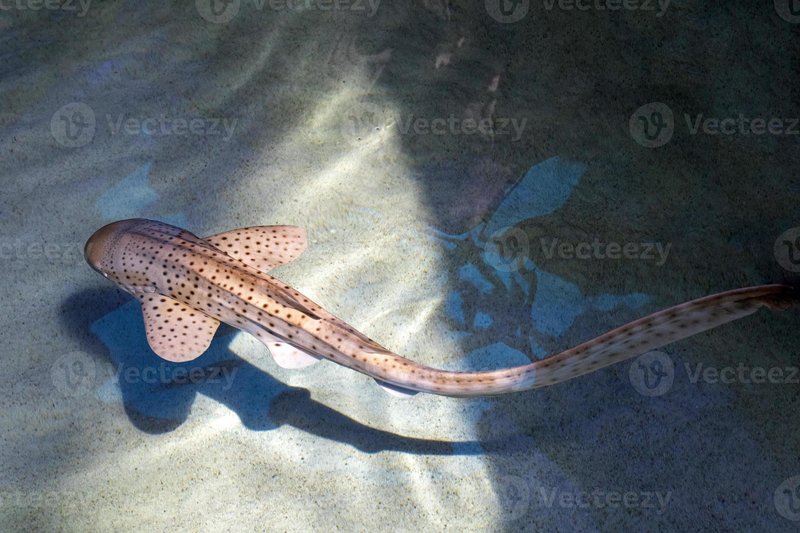
Let’s dive into the adaptations of the zebra shark — also known as *Stegostoma fasciatum* — and explore how they navigate their environments, hunt for food, and protect themselves from predators. These sharks can be found in the warm waters of the Indo-Pacific region, primarily inhabiting coral reefs and sandy bottoms. So, how do they make the most of their underwater world? Stick around, and we’ll uncover the secrets of their survival.
Distinctive Body Shape
One of the first things you might notice about zebra sharks is their unique body shape. They have long, slender bodies that help them move easily through the water. This body shape is designed for agility, allowing them to twist and turn with ease when darting after prey or navigating through tight spaces in the reef.
This streamlined design is a huge advantage. It helps reduce water resistance, enabling the zebra shark to swim with minimal effort. Imagine trying to swim in a bulky life jacket versus gliding through the water with a sleek swimsuit; the difference is night and day! Zebra sharks use their flexibility to perform impressive movements, allowing them to change direction quickly when necessary.
Moreover, their body shape allows them to camouflage well in their surroundings. With the sandy ocean floor or rocky crevices as their backdrop, their ability to blend in helps protect them from predators. They often lie motionless on the sea bed, which can make them hard to spot.
Skin Texture and Coloration
Now, let’s talk about the skin of the zebra shark. It’s not just about looks; their skin plays a crucial role in their survival. The color and pattern of their skin help them blend into their environment, especially when they’re resting on the ocean floor. Young zebra sharks have distinct stripes, which fade into spots as they grow older. This change not only makes them look unique but also helps them adapt to their surroundings as they mature.
The texture of their skin is also worth noting. Zebra sharks have a rough surface due to tiny, tooth-like structures called dermal denticles. These give their skin a sandpaper-like feel and reduce drag as they swim. Think about how a sleek race car is designed to cut through the air; in the same way, these dermal denticles help zebra sharks glide smoothly through the water.
Additionally, their skin acts as a protective barrier. Just like the way a thick sweater keeps you warm and shielded from the elements, zebra shark skin helps prevent infections and injuries. It is tough enough to withstand scrapes and scratches from rocks or coral in their habitat.
Feeding Adaptations
When it comes to food, zebra sharks have some interesting feeding habits. Instead of being typical hunters like great whites, these sharks are more like the foragers of the ocean. They mainly feed on small fish, crustaceans, and mollusks. Their small mouths are located on the underside of their bodies, which allows them to suck in prey from the ocean floor easily.
They also have a unique way of hunting. Zebra sharks use a technique called “benthic feeding,” which means they search for food close to the bottom of the sea. They can often be seen stirring up the sand with their mouths to uncover hidden prey. You might wonder how they find their meals in such a big ocean — well, their keen sense of smell helps! They can detect scents in the water from quite a distance, making them effective hunters even in murky conditions.
This method of feeding allows them to thrive in environments where other predators might struggle. Instead of competing with faster sharks, zebra sharks have carved out their niche. They take advantage of the available food sources and can often be found hunting during the night, making them nocturnal foragers. Being active at night means less competition and more opportunities to fill their bellies!
Reproductive Adaptations
Zebra sharks have a fascinating approach to reproduction that contributes to their survival. They are oviparous, meaning they lay eggs, which sets them apart from many other shark species that give live birth. Female zebra sharks produce egg cases that are often called “mermaid’s purses.” These cases protect the developing embryos inside and can be attached to underwater structures, like rocks or coral, ensuring they’re safe from predators.
The egg-laying process is quite intriguing as well. Females can lay several egg cases at once, sometimes numbering over dozens. When conditions are just right, the eggs will hatch, giving rise to baby zebra sharks, or pups. These little ones are independent from the moment they come out, needing to fend for themselves immediately. This independence boosts their survival chances, as they can begin hunting for food right away.
Here’s the thing: laying eggs also allows the zebra sharks to reproduce even in less-than-ideal environments. If food is scarcer or conditions are tough, they can still find a suitable spot to lay their eggs. This adaptability is crucial for their long-term survival, especially as they face environmental changes.
Behavior and Social Structure
Zebra sharks have interesting social behaviors that help them thrive in their underwater world. They’re often seen resting on the ocean floor during daylight hours, which is a clever adaptation for conserving energy. This behavior is like taking a power nap; it allows them to save their energy for when they need it most, such as hunting at night.
While zebra sharks are mostly solitary creatures, they can sometimes be seen gathering in small groups. These social interactions can help them locate food sources more efficiently or offer some protection from larger predators. You might be surprised to learn that when they do come together, it’s usually not for long — they still value their independence.
Their social structure is fascinating and shows how flexible they can be. Sometimes, they’ve even been observed playing or interacting with each other, a behavior that’s not commonly seen in many other shark species. This social playfulness indicates a level of intelligence that contributes to their overall adaptability in changing environments.
Adaptations for Breathing and Sensory Perception
Breathing is vital for all animals, and zebra sharks have adapted their respiratory system to suit their underwater lifestyle. Like other sharks, they have gills that allow them to breathe in oxygen from the water. However, unlike some fish that actively pump water over their gills, zebra sharks can also breathe while being stationary, which makes them less vulnerable to predators.
Their sensory perception is another fascinating aspect of their adaptations. Zebra sharks have a special organ called the ampullae of Lorenzini, which allows them to detect the electrical fields produced by other living creatures. This is incredibly helpful, especially when hunting in murky waters. Imagine being in a dark room where you can’t see anything, yet you can feel where everyone is — that’s similar to what zebra sharks experience!
This heightened sense of awareness enables them to find prey even when it’s hidden beneath the sand. It’s like having a built-in radar system! Additionally, their keen eyesight helps them spot food and navigate through their environments. They may not have the best vision in brighter conditions, but it works perfectly for their nocturnal hunting style.
The adaptations that help the zebra shark thrive underwater are truly impressive. From their sleek body shape and camouflaging skin to their unique feeding habits and reproductive strategies, zebra sharks have developed a diverse set of tools that contribute to their success in the ocean. They remind us of the incredible ways life has evolved to adapt to various environments.
By understanding these adaptations, we can appreciate the complexity of marine ecosystems and the roles different creatures play within them. Protecting habitats where these sharks live is crucial, as their survival impacts the health of our oceans. So, the next time you think about zebra sharks, remember not just their beauty but also the amazing adaptations that allow them to thrive in the vast underwater world.

